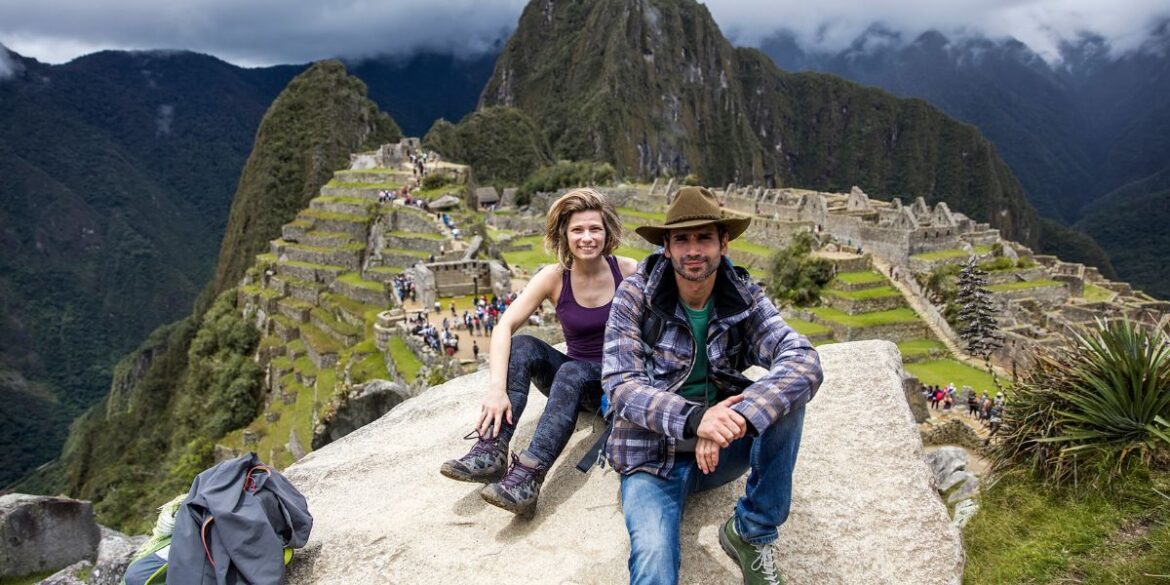Machu Picchu Travel Guide: Take a Luxury Hike to Machu Picchu Lodge-to-Lodge
Experience the mysteries and wonders of Machu Picchu on a 6-day 41-mile lodge-to-lodge hike along the Salkantay Trail with Mountain Lodges of Peru (“MLP”). This hiking itinerary provides the perfect blend of adventure, history, culture, comfort, and unparalleled views.
All along the Salkantay Trail the varied landscapes and terrain are dramatic and left us breathless. You pass through and by expansive green and beige valleys, tumbling waterfalls, flowing rivers, brown and gray splattered cliffs, towering snow-capped mountains, lush greenery and a turquoise glacier lake. All while you marvel at seemingly endless mountains as you hike above 15,000 ft. and traverse through a thick jungle.
If Machu Picchu is on your bucket list, and you love outdoorsy hiking adventures while preferring the comfort of deluxe boutique lodges at night, this is a dream trip for you. MLP has managed to combine hiking with luxury. Every aspect of the trip was well-organized and vastly exceeded our expectations.
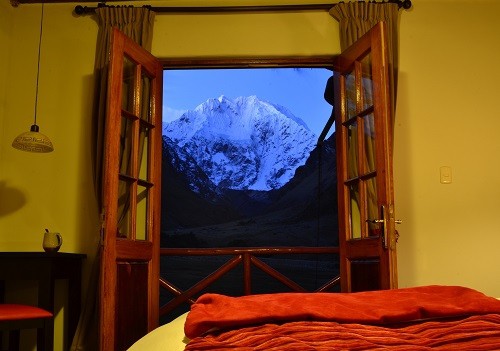
Lodges Along Your Route
We were pampered at the four lodges along the hiking route: Salkantay Lodge (12,690 ft.), Wayra Lodge (12,812 ft.), Colpa Lodge (9,414 ft.), and Lucma Lodge (7,003 ft.). The lodges are charming, remote, secluded, cozy, and surrounded by mountains. They have only 6 rooms to accommodate your group of 12, except the first lodge which has 12 rooms since you’ll stay there two nights to allow time to acclimate. The first three lodges (the first four nights) have outdoor Jacuzzis. 5 pm became Jacuzzi time for our group.
Upon arriving at each lodge, the staff greeted us and offered hot tea and hot towels on the cold days, and ice cold juice and cool towels on the warm days. There was a welcome table inside each lodge with tasty snacks laid out and a fully stocked bar. Our dirty hiking shoes were taken from us and cleaned as good as new. There were little pieces of chocolate on the nightstands and decorative towels on our beds. As we crawled into bed, our feet rubbed against hot water jugs keeping the bed toasty.
Expert Tip: Keep a flashlight by the bed for any middle of the night bathroom trips as the electricity turned off around 11 pm each night and came back on around 5 am. Consider requesting a room on the second floor at the Salkantay Lodge as only the second floor rooms have little balconies. Standing on the balcony gazing up at the stars and at Mount Salkantay was one of my favorite moments of the trip.
After the trek concluded, we stayed at Inka Terra in Aguas Calientes, which is a luxurious 80 room hotel packed in the middle of the city. The bustling city is forgotten once inside the walls. There’s a peaceful courtyard with an inviting swimming pool and fluttering hummingbirds.
Meals
Gourmet chefs followed us from lodge-to-lodge and prepared all our meals, including many 3-course hot lunches along the way, and 3-course delicious dinners. We were impressed with the quality, presentation, variety and tastiness of all our meals. Breakfast was always served precisely one hour before the hiking for that day commenced.
As we descended from the Salkantay Pass on day 3, we came across 3 tents (kitchen tent, dining room tent, and a bathroom tent) set up in the middle of nowhere with delicious smells emanating in the air. The dining room tent had a long table with 14 chairs complete with table cloths, porcelain plates, mugs, silverware, pepper grinders, and coffee service.
On day 4, we relished in a traditional Peruvian meal, Pachamanca. Our feast included grilled lamb, chicken, pork, guinea pig (eaten for nights of celebration in Peru) and an assortment of potatoes cooked in a hole in the ground by hot stones and covered in dirt.
When to Visit Machu Picchu & Cost
June through August — the most popular and most crowded time to visit Machu Picchu — is the peak of the dry season when the temperatures are a bit cooler. The winter solstice (June 21) — a sacred Inca day — is likely the busiest day of the year as there is an alignment between the sun, window, and rock at the Temple of the Sun when the sun rises.
Expert Tip: You may experience fewer crowds while still having pleasant weather conditions if you visit during the shoulder season (April, May, September, or October).
From April through October (the dry season) and December 15-31, this trek costs $3,990 per person sharing. If you love horseback riding, MLP also offers an equestrian ride to Machu Picchu for an additional $135. The accommodations: nearly all meals, transportation during the trek, guided tours and entrance fees are all included. Airfare, travel insurance, gratuity for your guides, and wine are extra. Gratuity is recommended at $5-10 per day per guide.
Expert Tip: The rainy season and warmer weather spans November through March. If you trek in March or November through December 14, you will experience fewer crowds, warmer weather, and save money as this trek is $2,990 per person sharing, but you will likely get wet.
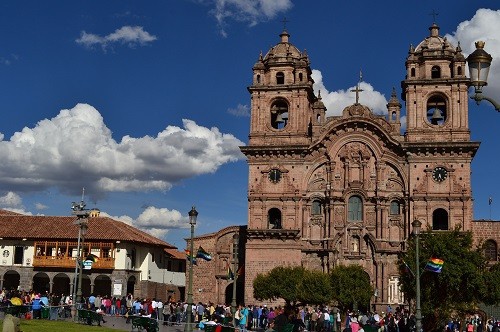
Travel to Cusco, Peru – Tours, Hotels & Restaurants
It is recommended to arrive in Cusco, Peru at 11,152 ft. above sea level a couple days prior to the start of the trek to allow time to acclimate to the higher altitudes. Use Kayak to get updates on the best deals on flights into Peru to receive notifications when flight deals arise to Cusco.
- Guided Tours from Cusco – You can use your extra days in Cusco for day tours to places such as Rainbow Mountain, Pisac Ruins, and Sacred Valley of the Incas. All of these tours are highly rated. Some are privately guided, others are with small groups.
- Where to Stay in Cusco – The Casa Andina Classic Cusco – San Blas had an outdoor enclosed courtyard, was walking distance to everywhere we ventured in Cusco, a 10 minute walk to the main square, Plaza de Armas, and a quick 20 minute drive to the airport.
- Where to Eat in Cusco – The dining options in Cusco are plentiful. We ate at Pacha Papa, Chi Cha, Greens Organic, and Inka Grill. While we loved all our meals in Cusco, Pacha Papa was our favorite. It had a soothing outdoor atmosphere in a courtyard sheltered from the rest of the city while we were serenaded by a Peruvian harpist. If you visit during the winter solstice parade or another time of celebration, the balcony from Starbucks on the second floor in the main square is a great spot to watch the elaborate parade and connect to free Wi-Fi.
- An alternative acclimation option is Lake Titicaca, the world’s highest commercially navigable lake at 12,507 ft. You can book a 3-hour boat tour of the lake here on Viator. We flew into La Paz, Bolivia, the world’s highest capital city at 11,942 ft., and took a bus to Copacabana, Bolivia that featured fabulous views of Lake Titicaca and a short ferry ride. We acclimated by relaxing along the shores of Lake Titicaca at Hotel Rosario Lago Titicaca, and then took a 10-hour bus ride (~$20 per person at the time of our trip) up to Cusco. Tickets Bolivia, Bolivia Hop (click to buy tickets), and Titicaca Travel Peru arrange bus fares. Titicaca Travel Peru also arranges private transfers.
Our room at Hotel Rosario Lago Titicaca was beautifully furnished, comfortable, modern, and had a quaint sitting area right next to large windows overlooking Lake Titicaca. Right outside the walls of our lovely hotel were little pigs, chickens, roosters, and other fun animals roaming around.
Day 1 – Trek to Salkantay Lodge
- Vehicle Transfers: 2 hours 40 minutes
- Marcocasa: 11,001 ft.
- Trek Distance/Time: 5 miles/6 hours
- Elevation Gain: 1,689 ft.
- Salkantay Lodge: 12,690 ft.
Your guides pick you up at your hotel in Cusco and transfer you to the start of the hiking trail at Marcocasa with a stop at Incan ruins along the way. The trail is very steep at times. The majestic snow covered Mount Humantay, reaching up to 17,956 ft. high, towers above you on one side. The even grander snow-capped Mount Salkantay nearly magically appears on your other side. Mount Salkantay at 20,574 ft. is a very sacred peak in Inca mythology and is the highest in the region.
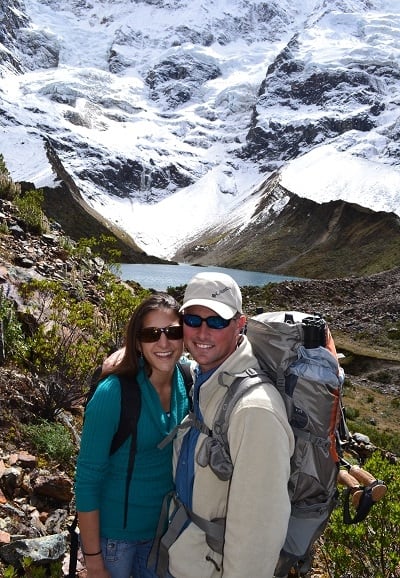
Day 2 – Acclimation Hike to Humantay Lake
- Elevation Gain: 1,155 ft. to Humantay Lake
- Trek Distance/Time: 4 miles/4.5 hours
- Lake Humantay: 13,845 ft.
You hike up to Lake Humantay and then back down to your lodge. Lake Humantay is turquoise, clear, and almost looks inviting with the majestic snow-capped mountain in the backdrop. If you’re so inclined, you may go for a swim.
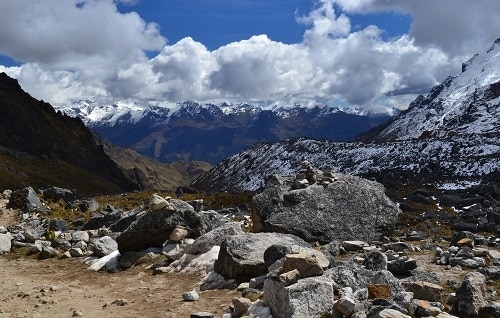
Day 3 – Salkantay Lodge to Wayra Lodge
- Trek Distance/Time: 9 miles/8 hours (including 1 hour lunch)
- Elevation Gain to Salkantay Pass: 2,523 ft.
- Salkantay Pass: 15,213 ft.
- Elevation Loss: 2,401 ft.
- Wayra Lodge: 12,812 ft.
The first three days of the trek, the temperatures kept getting colder as we ascended higher. As you make the final push to the Salkantay Pass, it is windy, steep, and intense as you steadily climb up switchbacks. It is by far the most physically exerting and challenging part of the hike. At the Salkantay Pass, the views of the snowcapped peaks of the Vilcabamba Range appear endless while the snow covered Mount Salkantay is beside you. Our time at the pass was intensified by the fierce rumblings caused by distant avalanches.

Day 4 – Wayra to Colpa
- Trek Distance/Time: 6 miles/4 hours
- Elevation Loss: 3,398 ft.
- Colpa Lodge: 9,414 ft.
Day 5 – Colpa to Lucma
- Trek Distance/Time: 10 miles/6.5 hours (including 1 hour lunch)
- Elevation Loss: 2,411 ft.
- Bus: 45 minutes
- Lucma Lodge: 7,003 ft.
As you descend on days 4 and 5, your surroundings become more tropical and the temperatures become warmer. You trek into the rainforest and continue to lose elevation. The warmth and lower altitude brings out mosquitoes and bugs. You hike along the edge of the mountain and by waterfalls. Before arriving at your last lodge (on day 5), a vehicle picks you up and drives you ~45 minutes to the Lucma Lodge.
Day 6 – Lucma to Aquas Calientes
- Trek Distance/Time: 7 miles/6 hours
- Elevation Gain to Machu Picchu Viewing Spot: 1,971 ft.
- Lunch Viewing Spot: 8,974 ft.
- Elevation Loss to Train Station: 3,165 ft.
- Llactapacta Train Station: 5,809 ft.
- Train: 1 hour
- Aguas Calientes: 6,232 ft.
On your last day of hiking, you slowly and regrettably, at least for us, rejoin civilization. You meander up another ~2,000 feet to your first sighting of Machu Picchu from the distance, and then descend back down over 3,000 ft. to a train station to take you to Aguas Calientes.
During your journey, you may also have the opportunity to experience a sacred ceremony of an offering to the gods, learn how to make Pisco Sour, a popular and tasty cocktail in Peru, and visit a small family coffee plantation and learn how they peel, dry, bake, and ground up the beans to make coffee from their small wooden hut.
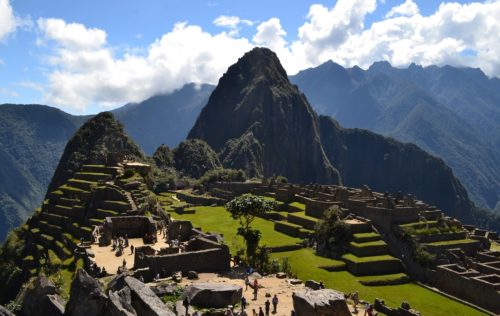
Day 7 – Machu Picchu
- Winding Bus to Machu Picchu: 25 minutes
- Machu Picchu: 7,972 ft.
- Train/Bus to Cusco: ~3.25 hours
The grand scale of the masterful architecture at Machu Picchu is inspiring. Machu Picchu, known as the Lost City of the Incas, built in the 15th century, contains more than 200 structures, including houses, sanctuaries, temples, terraced fields, water drains, and water fountains connected by channels.
The ancient city was abandoned in 1572 at the time of the conquest by the Spanish conquistadors. This historic gem remained mostly preserved over the centuries due to its location high in the Andes Mountains protecting it from enemies and boulders. The vast city was unknown until Hiram Bingham III’s discovery in 1911. It is still a mystery how the Incas managed to move and place the enormous stones.
While you walk around the ancient Lost City of the Incas and up and down uneven stone stairs, you learn about the history, daily life of the Incas, and the brilliance of the construction designed to be more earthquake-resilient. The mortar-free construction permits the stones to move ever so slightly and resettle. The terraces, once used for growing potatoes and other crops, are slanted inward to protect from erosion and landslides.
If you are interested in hiking up Huayna Picchu (the mountain behind the city that you see in the classic photos of Machu Picchu), ensure you book these tickets early as tickets are limited. We opted instead for a hike up to the Sun Gate for spectacular panoramic views of the ruins, which took ~3 hours roundtrip. Many choose to spend an extra day at Machu Picchu to allow plenty of time for both.
Packing List
The luggage weight limit permitted on the train to Machu Picchu is 18 pounds per person. Bringing layers each day was a necessity as there was often a fluctuation in weather.
- Daypack Backpack that you’ll carry during the hike
- Duffle Bag that is carried lodge-to-lodge by mules
- Camera Accessories – Camera, Extra Batteries, Battery Charger
- Warm Hat
- Baseball Cap
- Sunglasses
- Short Sleeve Shirts/Tank Tops
- Long Sleeve Shirts and Pants
- Sweater
- Jacket
- Rain Jacket
- Broken-in-Hiking Shoes
- Gaiters
- Hiking Sticks
- Water Bladder
- Insect Repellent
- Sunscreen
- Medications – Tylenol, Pepto Bismol, Diamox, Anti-diarrhea tablets
Frequently Asked Questions About Hiking to Machu Picchu
The optimal time to hike the Salkantay Trail to Machu Picchu is during the dry season, from April through October, with the peak months being June to August. This period offers cooler temperatures and reduced rainfall, making it ideal for hiking. However, these are also the busiest months at Machu Picchu. For those seeking a less crowded experience, the shoulder months of April, May, September, and October provide a wonderful balance of pleasant weather and fewer tourists. Keep in mind, trek costs vary seasonally, with higher rates during the dry season.
Accommodations along the Salkantay Trail are in the form of deluxe boutique lodges, operated by Mountain Lodges of Peru (MLP). These lodges offer a cozy, luxurious retreat after a day’s hike, featuring amenities such as outdoor Jacuzzis, gourmet meals, and personal service including laundry and room warming. With limited room availability to ensure exclusivity and personalized service, early booking is advised to secure your spot. Each lodge offers unique views and experiences, enhancing the overall journey to Machu Picchu.
Packing for a Machu Picchu hike requires careful consideration due to the varying climates and terrains. Essentials include layers of clothing to adapt to changing weather, broken-in hiking shoes, a rain jacket, insect repellent, and a sun hat. Additionally, a daypack for daily hikes and a duffle bag for luggage carried lodge-to-lodge are necessary. Don’t forget camera accessories for capturing breathtaking landscapes, and personal medications for altitude sickness and general well-being.
Yes, hiking in Machu Picchu is not just a physical journey but also an immersive cultural experience, especially along the Salkantay Trail. Travelers will have opportunities to engage in traditional ceremonies, learn about local agriculture including a visit to a coffee plantation, and even participate in a Pachamanca, a traditional Peruvian meal cooked underground. These experiences offer a deep dive into the rich cultural heritage of the region, making the journey to Machu Picchu even more memorable.
